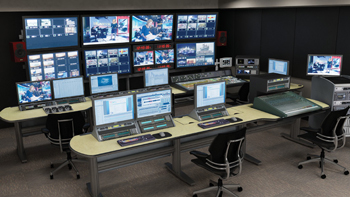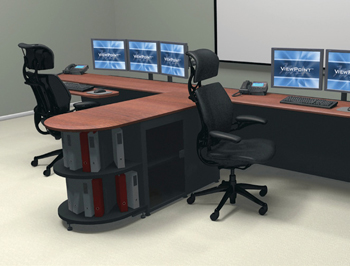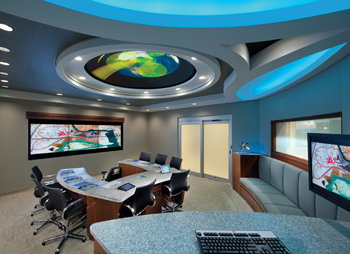Eye on Furniture: Designers Take Modular Approach

TBC Consoles SmartTrac Production Control Room
OTTAWA—Computers have taken over TV broadcast/production facilities, so it comes as no surprise that the size, shape and function of modern broadcast furniture is being driven by IT requirements.
FLEXIBILITY A MUST
In the days before computers took over television, broadcast furniture—especially consoles— had to be designed to hold and combine a wide range of unique broadcast-only equipment . This equipment was packed in cases of varying shapes and sizes; most of which didn’t fit into a “one-size-fits-all” solution.
At the time, the only options for broadcasters was to buy furniture that was either custom or “off the shelf.” The first were designed to meet a customer’s specific equipment roster—which “translated into long lead times, excessive cost and profound inflexibility,” said Bill Haberman, president/CEO of Forecast Consoles in Hauppauge, NY. In contrast, off-the-shelf consoles were cheaper and readily available. But actually fitting everything was difficult at best; impossible at most.
In today’s IT broadcast era, things have changed. Modern broadcast technical furniture is IT-oriented, which means that it is typically built upon a computer workstation model. This approach has allowed manufacturers to take a modular approach to furniture construction; allowing them to support custom designs while reducing costs and delivery times.
The result: “At Middle Atlantic, we combine in-stock modular frames and sections with custom-cut counters,” said Dave Amoscato, broadcast sales manager for Middle Atlantic Products in Fairfield, N.J.
“This allows our clients to come up with layouts that fit their working spaces, while leveraging the advantages of pre-built modules.”

On Middle Atlantic Products’ Viewpoint technical furniture, consoles are optimized for flexible flat-screen arrangements. As for shapes? “Most of these control systems are now running on PCs and servers, which have roughly standardized dimensions,” he replied. This means that although one size doesn’t fit all, a few sizes can suit most IT-based broadcast requirements.
The trend towards flexibility has also affected monitor walls. This trend has been added by the move to flat-panel monitors, which are far easier to mount, service and replace than old bulky CRTs.
A case in point: “Our TracWall system makes it easy for broadcasters to install any number of flat panels they want in any layout desired, and with enough space for easy adjustment, servicing and replacement,” said Jerry Hahn, president of TBC Consoles in Edgewood, N.J. “This is a big change from the days of CRTs, when monitors had to strictly conform to available rack space, were very deep taking up valuable floor space, and with extremely limited configuration options.”
SMALLER IS IN
The modern IT-based control room is loaded with PCs, servers, and keyboards. As a result, the cabinets, consoles and surfaces that hold this equipment can be smaller than the behemoth broadcast furniture of old—and they are.
“It’s not just the equipment that is smaller; much of it is remotely located in separate equipment rooms,” said Amoscato. “As a result, there is no need to pack so much into a control or editing room.” This fact is driving a trend to such rooms becoming smaller, or serving multiple purposes in one place; such as multi-user editing rooms.

Forecast Consoles recently installed this suite at a satellite positioning provider. In the pre-IT days, broadcast consoles and racks put storage first, operator comfort second. But again, times have changed: Operator comfort and accessibility has become just as important as storage.
In this modern age where ergonomics matter, “Desktops should be shallow enough to reach critical components yet allow enough leg room for comfort,” said Hahn. They should also have motorized lifts, to allow easy access for wheelchair users.
Put it all together and today’s broadcast furniture is more flexible to configure and re-use; takes up less space, and is more ergonomically sound. In other words, it is not just TV technology that has progressed, but also the structures that make it accessible to its human operators.
Get the TV Tech Newsletter
The professional video industry's #1 source for news, trends and product and tech information. Sign up below.
James Careless is an award-winning journalist who has written for TV Technology since the 1990s. He has covered HDTV from the days of the six competing HDTV formats that led to the 1993 Grand Alliance, and onwards through ATSC 3.0 and OTT. He also writes for Radio World, along with other publications in aerospace, defense, public safety, streaming media, plus the amusement park industry for something different.

